Is There an Irish Cuisine?
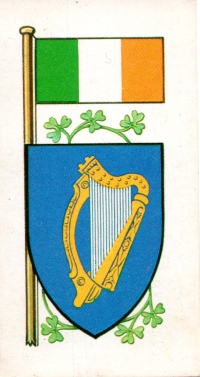
1. The retail landscape.
Someone visiting a large supermarket in the United States is likely to find a section of Irish foods near the Asian, Hispanic, Italian, Jewish and Mexican sections. The Irish offerings typically include canned beans, cookies, crackers, jams, savory preserves like piccalilli and pickled onions, oatmeal, teas, sauce and soda bread mixes, among other things. The meat counter may stock Irish bacon and sausage, black and white puddings and, sometimes, Irish boiling bacon (salt cured pork loin) to make the national dish with cabbage.
Almost certainly, the store will lack an English section, and although some British products will be stocked in the general grocery shelves with their American counterparts (Carr’s crackers, Colman’s mustard, Lea & Perrins Worcestershire--now made in New Jersey--Branston pickle, maybe, with the chutneys), Americans do not tend to identify these products as particularly British, let alone consider them elements of a distinctive cuisine.
What is left of the big bookstore chains and Amazon in both the United States and United Kingdom offer a selection of excellent contemporary Irish cookbooks. Almost every store stocks more titles about Irish than about English food, even though the population of England is some fifteen times larger; before it closed, the Wall Street branch of Borders Books typically shelved some eight Irish and two English titles among the hundreds of French and Italian choices. A number of Irish authors, including Myrtle and her daughter-in-law Darina Allen, and the Rankins, have written a number of beautifully illustrated books packed with appealing and accessible recipes.
In Ireland itself, a revolution no less exciting than the one sweeping Britain has transformed the choice and quality of food and restaurants. (The Editor notes that she has heard good things from numerous sources about the Allen establishment at Ballymaloe and eaten good but also, it must be noted, execrable, things at a number of restaurants in and around both Dublin and Belfast.)
2. Posing the question.
Under these circumstances it may appear churlish to wonder aloud or in print whether in fact an Irish cuisine exists. Two recent studies have answered the question with a resounding ‘no,’ but others have made the case for a coherent and distinctive Irish culinary tradition.
In his study of ethnic foodways in Britain, Panikos Panayi writes that
“The anomaly in our discussion is the Irish. The main reason for their lack of ethnic food would appear to be the absence of a distinct food culture in Ireland and a lack of distance from the products consumed by the ethnic majority of Britain.” (Panayi 64)
Panayi, however, also notes that in the postwar era, Irish food shops and supermarket sections have appeared in Britain; of course, he could have observed the same thing about the United States. His explanation:
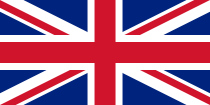
“The main reason for the lack of Irish food shops in Britain before 1945 clearly does not lie in the size of available market. Instead, we find an explanation in the fact that Irish food did not have enough distinction from that of the ethnic majority to warrant the opening of specifically designated food shops. Only at the end of the twentieth century, when cuisines became commodities connected with nationality, did the concept of Irish food emerge. What the Irish ate has not formed a distinguishing factor.” (Panayi 43)
Hasia Diner also is unequivocal in her study of immigrants’ foodways in the United States. In a background chapter that discusses food in Ireland itself, Diner notes that “[f]ood lay at the margins of Irish culture as a problem, an absence, a void…. Ireland also failed to develop an elaborate national food culture.” (Diner 84, 85)
Diner is not sure why, and notes that other cultural or ethnic groups, including African Americans, Japanese, Jews, Mexicans and the Ojibway, all of whom at various times were either reliant on a food monoculture, beset by starvation or both, nonetheless retained and enhanced their distinctive food traditions both during and after the hard times. (Diner 98-101) According to her, “[t]he Irish attitude toward food seemed to have been very different from that of these other men and women. They did not relish pre-trauma food memories, nor did they take the one powerful food they had and transform it into a group identity.” (Diner 101)
3. Hitting the (cook)books.
Neither Panayi, who writes extensively about other ethnic food authors, nor Diner provides any analysis of Irish cookbooks. Historically, there are comparatively few of them. The paucity of Irish cookbooks, however, does not mean that Irish recipes went unrecorded. Enterprising researchers including Theodora FitzGibbon and Alison Rosse between them have found a trove of domestic manuscripts from the seventeenth century on.
Recipes also have appeared in cookbooks covering British food. During the 1960s, for example, Time-Life books published a superb series on “Foods of the World” that included volumes on regional American foods, cuisines of the Viennese empire and of Scandinavia, along with the more usual suspects. There is no volume on Irish food. This was no oversight: Instead, Adrian Bailey, the noted scholar who edited the series, included Ireland as a culinary region in Cooking of the British Isles. This was, of course, before our era of political correctness or, to paraphrase Panayi, cultural nationalism.
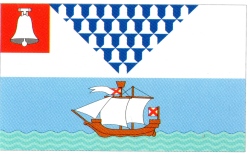
At a time when anything Irish radiated a romance in the afterglow of the American Camelot, Bailey’s description of Irish foodways is enthusiastic if overstated. The book does describe items indigenous to Ireland but some of them, like Belfast ham, are hardly unique to the island. Others are undeniably Irish in character, including barm brack, boxty, Dublin coddle and soda bread. These are wonderful things to cook and eat. It is hard not to notice, however, that there are not many of them. Is Bailey’s treatment an oversight, or does it reflect a basic truth?
The redoubtable Jene Grigson does not provide the answer; although she included a chapter on Irish food in her excellent Observer Guide to British Cookery, it is an afterthought. From a total length of 211 pages, the Irish chapter includes only ten lavishly illustrated pages of recipes, and most of them could just as well be English. As Mrs. Grigson, who demonstrates no lack of affection for Ireland and its food, notes of her recipe for pork ciste, “[t]his kind of pie-in-a-pan is also made in the north of England, from west across to east.” (Grigson 205)
4. Regina Sexton makes her case for an Irish cuisine.
Mairtin Mac Con Iomaire and Dorothy Cashman decry “the pervasive, but erroneous belief that Ireland lacks a distinctive cuisine,” but instead of describing one offer only a bromide: “Absence of evidence does not constitute evidence of absence.” (Mac Con Iomaire 81)
Regina Sexton, whom they cite, does make the case for a unique Irish food tradition in A Little Historyof Irish Food: “Over the millennia, food in Ireland has done much more than simply nourish the body; it has through time soaked up mythological and folk belief….” (Sexton 7) This, however, is not a good book and could just as aptly have been entitled A History f Little Irish Food. Its flyleaf describes Sexton as “Ireland’s foremost food historian” but on the evidence of this effort she is more cheerleader than analyst. For example, in a flight of speculation, she says that the Irish, not the Swiss, may have “invented” muesli.
Sexton serially substitutes anachronism for insight, and based on this ‘study,’ her readers should be forgiven for observing with Allan Blackstock that “Ireland, more than most countries in the English-speaking world, has been undergoing a long and often silly argument about the nature of colonialism and its own national history, culture and society.” (Blackstock)
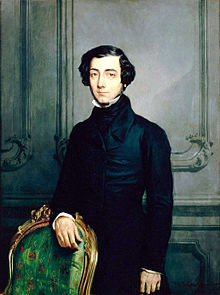
A French traveler
Sexton’s book reflects less research and includes less content even than its short length might indicate. She relies heavily on anecdote, speculation and Arthur Young (itself not a bad thing, but she ignores other sources) and shows little historical sense. Tocqueville is described as “a French nobleman, who travelled to Ireland in 1835,” which is a bit like describing Lincoln as an Illinois rustic who visited Richmond in 1865. Reading a Fianna Fail recipe pamphlet from 1936 “with glee,” she is “delighted” until she finds a “suspect advertisement” by a Dublin butcher claiming that “all young girls aspire to the married state and within this station their cookery talents will prosper.
Interestingly, this dogma also reappeared in another government publication, Eamon DeValera’s 1937 Irish Constitution.” (Sexton 31) So Sexton would have us believe that a butcher’s advertisement prefigured the creation of ‘another government document,’ the Irish constitution.
In what apparently is intended to pass for analysis, Sexton also declares that: “Nowadays, many people find these sentiments offensive, since they may be seen to convey the idea that a woman’s place is in the home, where she will presumably cook away to her heart’s content, maybe using her 1930s government cook book, until her hungry husband comes home.” (Sexton 31) This is speculative anachronism; female domesticity was a foundation of DeValera’s long grip on Irish office and society, as well as the reality for the overwhelming number of Irish women until well after the Second World War.
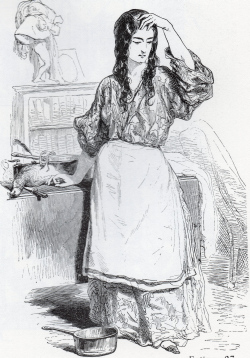
Things do not improve: Sexton’s breathless discovery of sexism is followed by a garbled and historically inaccurate discussion of a dish with the “curious name” of “Sea Pie.” She decides to rename it “DeValera’s pie” because it appears in the 1936 government cooking pamphlet. There is, however, nothing particularly Irish about Sea Pie and the name is entirely logical: The preparation originated in the Royal Navy and got its name because it was made from ships’ stores of preserved food including corned beef, salt pork and hardtack.
More of Sexton’s ‘Irish’ dishes, like stuffed goose, apple Charlotte (named for an English queen), baked ham and toffee apples, are hardly unique to Ireland and did not originate there. As previously noted, some preparations including barm brack, porter cake and Dublin coddle are originally and authentically Irish. Sexton never mentions them.
It is equally unfortunate how the Little History parades the stock sentimentality (“the sharing spirit which gelled small rural communities together”) that afflicts much of Irish popular history. (Sexton 54)
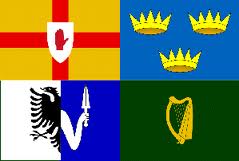
Sexton’s earlier introduction to Darina Allen’s Irish Country Cooking is better. There she discusses the various peoples of Ireland and their contributions to the national food culture. Her cheerleading cedes the floor to tacit agreement with Payani and Diner when she explains that the “diversity of culinary traditions” in seventeenth century Ireland following the arrival of Norman, Scottish and English settlers (or conquerors) had collapsed by the nineteenth century.
That collapse came from below due to poverty, population pressure and the consequent emergence of a food monoculture. It came from above via the increasing Ascendancy taste for English fashion. Country house recipe manuscripts from the 1800s include a raft of English recipes as well as curried eggs, Swedish pancakes and Viennese chicken. Lesser but not impoverished families on both sides of the religious divide cooked things like steak and sausage stew or macaroni pudding. (Sexton in Allen 12-14) As a result, and also because wild ‘famine foods’ like game, oats and wild greens had become associated with poverty,
“Irish food throughout the first half of the twentieth century remained overwhelmingly conservative…. A good square meal of plain food became symbolic of economic comfort and security. Until well into the 1960s the average Irish dinner was the invariable trio of meat, vegetables and potatoes, bulked out with white buttered bread and washed down with lashings of strong tea.” (Allen 14, 15)
This description is indistinguishable from England at the time.
Sexton wrote the columns on ‘Ireland,’ ‘Irish Stew,’ ‘Boxty,’ ‘Colcannon’ and other Irish items (but not barm brack) in The Oxford Companion to Food but they do not expand on the analysis in A Little History or the ‘Forward’ to Irish Country Cooking. Unlike most western cuisines discussed in The Oxford Companion (including England and Scotland), the reference book includes no narrative by Sexton or anyone else on Irish cookbooks. Sexton’s essays in The Oxford Companion cite her own work along with Theodora FitzGibbon, Florence Irwin, Maura Laverty, Biddy White Lennon, A. T. Lucas, Brid Mahon and Monica Sheridan; other than FitzGibbon, Lucas and maybe Irwin, not necessarily a confidence-inspiring bunch, but perhaps they represent the most widespread sources of Irish recipes in print.
Incidentally Davidson devoted only three pages to Ireland in his entire 865 page Companion, but then he also gave short shrift to both ‘Louisiana’ (no entry; less than a page for ‘Cajun’ and that entry is not particularly good) and ‘England’ (but a little more than 6 pages including a separate section on English cookery books), among others.
5. Irish contemporaries.
Despite its title, Land of Milk and Honey: The Story of Traditional Irish Food and Drink offers virtually no information about Irish cookery. Its authors do reproduce eleven ‘traditional’ recipes “from Irish country houses and hotels,” but all of them appear in other publications. (Mahon & Watkins 152-62)
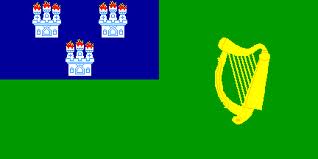
Neither Darina Allen nor the Rankins dispel the notion that Irish food is particularly distinct from British food. The Rankins take a cosmopolitan and innovative approach; theirs is food that is cooked in Ireland rather than Irish food. Allen is more self-consciously Irish, but by the most generous count less than a dozen of her excellent recipes from Irish Country Cooking (her Traditional Irish Foods is substantially the same book, and so is her mother-in-law Myrtle’s 1990 Cooking at Ballymaloe House) are distinctively Irish rather than British.
Issues of Bon Appetit (from 1996) and Saveur (in 2006) similarly reinforce the perception that Irish foodways are essentially British. The Bon Appetit feature is more of a reach; it includes a recipe for an ‘Irish’ pizza and some risible padding, such as “[t]he great masterpieces of Irish food arrive at the table as a blessing of the Irish climate, the Irish countryside and the Irish people.”
Richard Corrigan grew up in rural Ireland and runs Corrigan’s Mayfair, a distinctly luxe restaurant in London. We would not argue that his background is irrelevant to his food, but any influence stems more from the fact that he lived in the country rather than in Ireland. His cookbook, The Clatter of Forks and Spoons, is more a plea for slow food and local sourcing than an attempt to define his dishes as inherently Irish. Corrigan is a paradigm of our confessional age, and intersperses culinary as well as personal memoir amongst his recipes. Avowed influences include the English authors Elizabeth David, Jane Grigson and Constance Spry and the recipes in The Clatter display that lineage. As the Duke of Wellington said of his own Dublin origin, the fact that one was born in a stable does not make him a horse.
Clodagh McKenna takes an international approach to slow food in The Irish Farmer’s Market Cookbook. An alumna of Ballymaloe House, McKenna also is a television personality in Ireland and her book is a tie-in to an RTE series of programs. It is a nice book with anecdotes about heritage breeders, responsible farmers and dedicated culinary artisans. If, however, carragheen and crubeens pop into the book, so does chorizo, couscous, pesto and tzatziki.
If these contemporary books and articles do not establish a distinct Irish culinary tradition, they do not disprove one either. Their mission is more the dissemination of good cooking in Ireland, less an examination of indigenous food.
6. Others make the case.
Older cookbooks published in Ireland do attempt to place Irish foodways in a national context: Unsurprisingly, they vary in quality. Some are excretions of the sentimentality industry; others are remarkable, but none is irreducibly Irish. The first category may be dispensed with immediately. The worst probably is My Irish Cook Book from 1966 by Monica Sheridan. As its flyleaf warns,
“[p]reparing these dishes will never be a chore, for Monica Sheridan garnishes her text with childhood memories and seasons it with Celtic wit, creating an Emerald Isle atmosphere that will surely have a subtle effect on your cooking and permeate the dinner table [sic].”

This is writing in the sentimental elegiac mode; later, Sheridan adds a sideline in grievance and anachronism. The famine is never far away, but, in a vision of rhapsody of rural autarky, sturdy men come home from the fields hungry for their wives’ wholesome cooking. There is tubthumping too: “In many ways ours is a simple diet, but--as all the world knows--it has nourished a complex and remarkable assortment of poets and playwrights, politicians and pugilists, actors and orators, philosophers and wits.” (Sheridan xvi) Myles na gCopaleen would have had a field day with this.
All of this might, possibly, be forgiven if the recipes were useful, but there is nothing original in My Irish Cook Book, almost nothing particularly Irish and when Sheridan prepares Irish dishes she frequently fails. Dublin coddle for instance is an exemplar of Irish food. The marriage of sausage, bacon, butter, greens and tuber is simple, delicious, economical and indigenous to the island; an urban, cured pork cousin of Irish stew. Sheridan does not like it:
“I must say that I could live without Dublin Coddle, but if I thought it would make me write like Dean Swift then I would be quite prepared to lump it and like it.” (Sheridan 73-74)
Her dislike may be explained by the ridiculous omission of potatoes (though “[s]ometimes a few sliced potatoes are added but this is not orthodox”), butter, scallions or peas from her recipe. (Sheridan 74) The problem is compounded by the stingy garnish of bacon and single pound of sausage that she specifies for six servings, a quantity that could be adequate only because nobody would want to eat what amounts to plain boiled sausage.
Traditional Irish Cooking by Biddy White Lennon is a more recent (1990) effort to identify an Irish cuisine that at first appears equally easy to dismiss. It contains much unsourced anecdotal ‘history’ and many anachronisms, but also includes some appealing recipes.
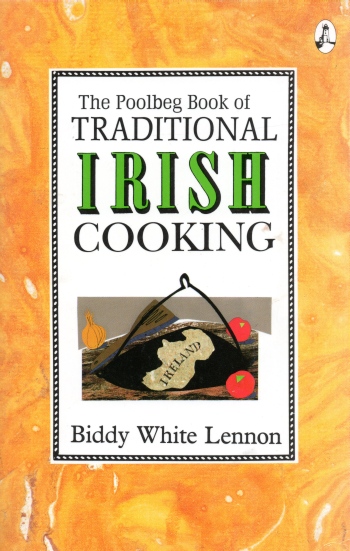
Lennon hits the high notes of Irish food--she gets coddle right, identifies bacon and cabbage as the national dish, cooks a good Irish stew and discusses soda bread. Traditional Irish Cooking includes some of the more unusual (bacon, pea and barley soup) preparations and sound innovations like Myrtle Allen’s dressed crab (it uses chutney and also appears in Darina Allen’s books) and an oatmeal sweet. These, however, are exceptions; British preparations dominate Traditional Irish Cooking as well as her subsequent Irish Food and Cooking, co-written with Georgina Campbell. White Lennon therefore also fails to describe a discernable Irish cuisine rather than a regional variation on our larger theme.
7. An internet interlude.
Other Irish authors take a different stab at authenticity by offering innovative abominations. Unhappy examples are offered online at www.cordond’orcuisine.com/newirishcuisine.html. One is ‘Blarney Salmon,’ a mound of cold mashed fish smeared with avocado and food coloring to resemble the Irish flag. Another is ‘Gammon of the Isles,’ a ham studded with maraschino cherries and canned peaches. The website helpfully notes that “the Irish taste for ‘curry’ spices…stems from the famine years, when curry powder was made available to flavor the inedible food.” This is fatuous enough for a comedy routine.
Those probably are enough bad examples, and while we could cite more of them, useful ones may be more interesting to the pragmatic readers of britishfoodinamerica.
8. Back to the (better) books.
Maura Laverty published her Cookbook in New York during 1947; it previously had appeared in Ireland entitled Kind Cooking for some reason. This was marketed as a ‘heritage’ cookbook to the domestic Irish and latterly Irish-American market, but is not particularly Irish after all. It includes recipes for Scotch broth, a Norwegian cauliflower soup, a Spanish cod dish, several curries (from the famine, perhaps?), Swedish and Danish meatballs, a Dutch apple cake and other international entries including the usual Irish predilection for English dishes. The author, who trained in Spain and had planned to publish a volume of recipes called Cooking Round the World, appears to have intended to improve the quality and extend the repertoire of Irish cooks rather than carry a torch for their native cuisine.
That is somewhat surprising given Laverty’s other endeavors. She was a television personality and popular author whose 1942 novel Never No More was a bestseller in Ireland during the Second World War “emergency,” when Ireland remained neutral and suffered food shortages. It is awash in the sentimentality that plagues much twentieth century Irish popular culture and would have meshed seamlessly with the philistinism that the DeValera government cherished. As Clair Wills notes in her excellent study of Ireland during the Second World War, “Laverty was also a cookery writer and her novel dwells on traditional recipes, which must have been mouth-watering for those unable to get hold of ingredients during the war.” (Wills 297) Given Laverty’s biography, it is fair to infer that if Ireland did have a more robust catalog of indigenous recipes, then she would have replicated it rather than taking a cosmopolitan approach.
She has an interesting recipe for stuffed fish and a strange variation on strawberry fool that is a mangled trifle more than a true fool.
9. North to Ulster.
Two publications written by Northern Irish Protestants require mention both in their own right and to balance the sectarian books.
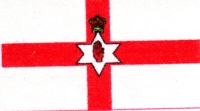
The Belfast Cookery Book by Margaret Bates requires little attention in the context of this essay. The book is not at all bad but not particularly Irish, let alone focused on Ulster foodways. The author’s stated purpose was to teach what used to be called home economics to Northern Irish girls in a more sexist and less euphemistic age. Like Laverty, Bates sought to improve the quality of domestic cooking. She provides clear instructions and some helpful background for the novice: “Curries are universally known, but have their origin in countries with a hot climate, notably India and Africa.” The bibliography lacks Irish sources but does include French (Larousse) and English ones (Elizabeth David, Constance Spry--good choices).
Florence Irwin is more interesting and problematic than Bates. She too taught young women to cook, but as an “Itinerant Cookery Instructress” for the (British) Department of Agriculture and Technical Information for Ireland. In that capacity she traveled throughout County Down from 1905-13 with a portable stove and other cooking equipment. Her 1949 book, The Cookin’ Woman, includes both reminiscences and “recipes for our folk cookery.” (Irwin 2)
Irwin’s tone can be brusque, not unlike David’s, and betrays a steady backbeat of soft Presbyterian bigotry or perhaps patronization toward her Catholic charges. There are stock “Paddy” anecdotes and jokey tales of Irish incongruity.
For all that, hers is a good book. Its recipes are clear and practical. Irwin differentiates dishes predominantly Catholic or Protestant (one preparation is “unknown in the Scottish portion of Ireland”) from those prepared all over the island. (Irwin 208) The short chapter on “Irish Country Recipes for Fast or Feast Days” has four or five distinctly Irish dishes.
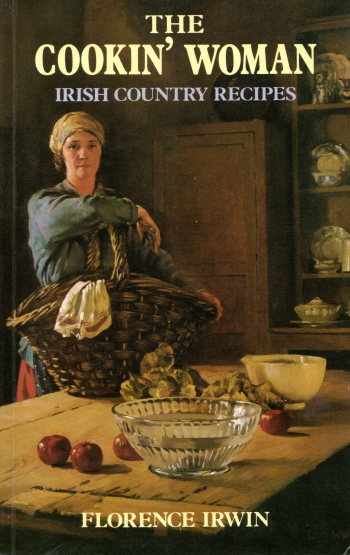
Despite her stated aim of chronicling an Irish set of foodways, however, Irwin’s sources also are predominantly English. Her chapter on “Old Cookery Books” does not include any Irish publication but relies instead on sound English ones; Price (1720), Nott (1723), Hunter (1790), Glasse (1796), “A Lady” published in England sometime after 1800, Kitchener (1817), and of course Mrs. Beeton. Therefore, while Irwin includes some interesting recipes, The Cookin’ Woman provides insufficient evidence of a distinctive Irish cuisine, probably because it did not occur to its author to look for one. Her writing indicates that, like many northerners of her time, Irwin considered herself at least as British as Irish.
10. We saved the best for last.
All of which brings us to Theodora FitzGibbon. This remarkable woman personified the cultural interchange between the nations of the British Isles and Empire during the first half of the twentieth century.
As her books invariably note, FitzGibbon was “born in London of Irish parents.” Her father produced a number of children on both islands, each by a different mother, but spent most of his time as a civil servant posted to India. He would arrive in England unannounced at infrequent intervals to whisk Theodora off to the crumbling family estate in Ireland.
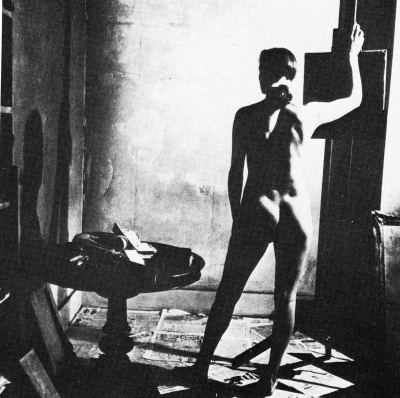
Ms. FitzGibbon at work
FitzGibbon herself was a model (fashion and nude), West End actress, muse, esteemed cook, editor (of cookery columns for the Irish Times), firewatcher (nearly killed in the London Blitz) and author. She wrote innumerable magazine articles and more than 25 books. Among them was a remarkable memoir of Paris, where she ran with the prewar art crowd that included Ernst, Giacometti, Mesens, Picasso and the rest. FitzGibbon also belonged to the wartime Fitzrovia set; Dylan and Caitlin Thomas were her friends, and she knew Norman Douglas and Phillip Toynbee along with other cultural notables. Then she lived in the United States for a time and, eventually, settled in Ireland.
11. The British variations.
In 1983, FitzGibbon wrote (our apologies to Darina Allen) what remains the best of Irish cookbooks. Irish Traditional Food substantially expanded the range of recipes that had appeared in FitzGibbon’s previous volume, A Taste of Ireland. The earlier book appeared as part of her illustrated ‘Taste of’ series on traditional foods that covered Scotland, Wales, the English Lake District, the West Country, Yorkshire, ‘The Sea,’ London, Paris and Rome. The volumes on the British Isles, taken together with Traditional Irish Food, indicate that in culinary terms Ireland is a significant variation on the British model, but a variation less distinct from England as a whole than the English regions and Scotland are from one another. Wales, by the way, is similarly indistinct from its neighbors in the archipelago.
To compile Irish Traditional Foods, FitzGibbon conducted a vast amount of research that concentrated on what Irish people have cooked over the years rather than on recipes that originated in Ireland. Thus, she notes that her recipe for convent eggs is “adapted very slightly from [Alexis] Soyer’s A Shilling Cookery for the People (London 1859),” a book “which circulated in many parts of Ireland after Soyer came over to help provide edible food for the famine victims. My copy originally belonged to my aunt in Clare and was much used by her.” (Irish Traditional Food 42)
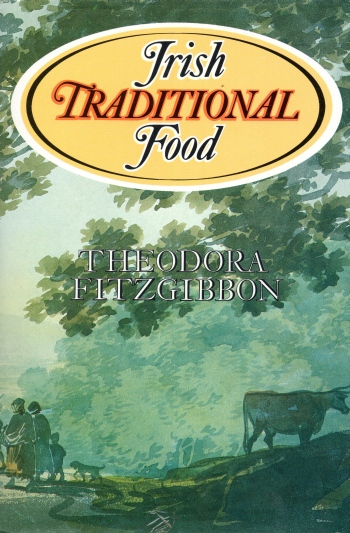
Many of these are equally at home in her Art of British Cooking but come from Irish rather than English kitchen manuscripts. There is a pea soup (London Particular); potted meats and seafood, all seasoned with mace; devils of many kinds; fried whitebait; jellied eels; chicken and leek pie with ham; boiled turkey; spiced beef for Christmas; roast beef with batter (aka Yorkshire) pudding; steak and kidney pie; boiled mutton with caper sauce; raised pork (and other) pies; bread sauce for birds (“first recorded in Scotland in the eighteenth century and… no doubt brought to Ireland by the many Scottish settlers who arrived in the seventeenth and eighteenth centuries”); white sauce and all its variations; an artichoke pie; apple Charlotte; bread pudding; gooseberry fool; summer pudding; syllabub and more. All of these recipes are good and all of them are British. (Traditional Irish Food 125 and passim)
If any doubt remains about the British origin of most Irish dishes, we need look no farther than Myrtle Allen herself, founder of the Ballymalloe Cooking School and George Washington of the Irish culinary revolution. In 2000, she explained that Elizabeth David had been the inspiration for much of her food:
“It was the publication of Spices, Salt and Aromatics [in the English Kitchen] that won me over… I almost learned by heart her chapter on individual spices. Her recipes entered our repertoire and, I think, will stay on our tables for ever!” (Spices flyleaf)
None of this is meant to denigrate Irish foodways. As noted earlier, excellent food may be found in Ireland and the country does boast some notable dishes--Brotch’an Roy, the ancient oatmeal soup that nonetheless bears a more than passing resemblance to an equally early Scottish preparation; buttered eggs; dressed crab with chutney (probably first paired by Myrtle Allen); Dublin coddle; boxty; barm brack; porter cake; soda bread; yellowman and a couple of others.
But like it or not, Ireland was for centuries dominated politically, economically and culturally by its big neighbor to the east, and in 1800 joined the United Kingdom for some twelve decades. Understandably enough, that dominance is reflected in Irish foodways. Even so, as Panayi notes, a ‘distinct’ Irish cuisine has been promoted by the heritage industry since 1945. The sentimental nationalists rather than any robust indigenous tradition have made possible those ‘Irish’ sections in American supermarkets and ‘Irish’ cookbooks in the shops and on the net.
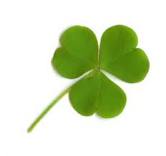
Perhaps, as it became possible to transcend tribalism and colonial resentment with the emergence of a confident if now tattered Celtic tiger, it became possible to accept the multicultural history of the island with its Old English, Norman, Scots-Irish and Ascendancy as well as Celtic and Catholic antecedents. After all, Irish foodways as they are re-emerging, reinvented and accepted throughout the country are based predominantly on English and Ascendancy foodways. That would have been unthinkable a generation ago. In the same way as the nation (finally) embraced the stunning architectural heritage of Dublin as Irish despite its Protestant origins, Ireland has invented an inclusive ‘traditional’ cuisine based on a past that never quite existed. On reflection, that cannot be a bad thing.
A sampling of Irish recipes appears in the practical.
Sources.
Darina Allen, Irish Country Cooking (New York 1995)
Myrtle Allen, Cooking at Ballymaloe House (New York 1990)
Margaret Bates, The Belfast Cookery Book (Oxford 1967)
Alan Blackstock, “Ireland and Empire,” History (March 2001)
Georgina Campbell & Biddy White Lennon, Irish Food & Cooking (London 2004)
Alexander Cockburn, “Gastro-Porn,” The New York Review of Books (8 December 1977)
Richard Corrigan, The Clatter of Forks and Spoons (London 2008)
Elizabeth David, Spices, Salt and Aromatics in the English Kitchen (London 1970, 2000)
Alan Davidson (ed.), The Oxford Companion to Food (Oxford 1999)
“Delicious Ireland (includes 5 discrete articles),” Saveur No. 91 (March 2006)
Theodora FitzGibbon, The Art of British Cooking (London 1965)
Irish Traditional Food (Dublin 1983)
A Taste of Ireland (Boston 1969)
Jane Grigson, The Observer Book of British Cookery (London 1984)
Florence Irwin, The Cookin’ Woman: Irish Country Recipes (Belfast 1949)
Martin Mac Con Iomaire & Dorothy Cashman, “Irish Culinary Manuscripts and Printed Cookbooks: A Discussion,” Dublin Institute of Technology School of Culinary Art and Food Technology Articles (Year 2011) 80-101
Clodagh McKenna, The Irish Farmers’ Market Cookbook (London 2009)
Brid Mahon & Kathleen Watkins, Land of Milk and Honey: The Story of Traditional Irish Food and Drink (Dublin 1991)
Paul and Jeanne Rankin, Gourmet Ireland (London 1994)
Gourmet Ireland Two (London 1995)
“The Romance of Ireland (6 discrete essays),” Bon Appetit, Vol. 41 no. 5 (May 1996)
Regina Sexton, A Little Book of Irish Food (London 1998)
Monica Sheridan, My Irish Cook Book (London 1966)
Rosie Tinne, Irish Countryhouse Cooking (New York 1974)
Clair Wills, That Neutral Island: A cultural history of Ireland during the Second World War (London 2007)

